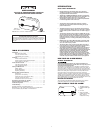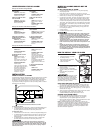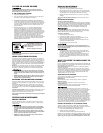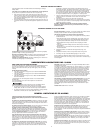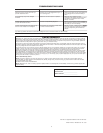
WHAT LEVELS OF CO CAUSE AN ALARM?
Underwriters Laboratories Inc. Standard UL2034 requires residential CO Alarms
to sound when exposed to levels of CO and exposure times as described
below. CO levels are measured in parts per million (ppm) of CO over time (in
minutes).
UL2034 Required Alarm Points*:
• If the alarm is exposed to 400 ppm of CO, IT MUST ALARM BETWEEN
4 and 15 MINUTES
• If the alarm is exposed to 150 ppm of CO, IT MUST ALARM BETWEEN
10 and 50 MINUTES.
• If the alarm is exposed to 70 ppm of CO, IT MUST ALARM BETWEEN
60 and 240 MINUTES.
* Approximately 10% COHb exposure at levels of 15% to 95% Relative
Humidity (RH).
The unit is designed not to alarm when exposed to a constant level
of 30 ppm for 30 days.
CO Alarms are designed to alarm before there is an immediate life threat.
Since you cannot see or smell CO, never assume it’s not present.
• An exposure to 100 ppm of CO for 20 minutes may not affect average,
healthy adults, but after 4 hours the same level may cause headaches.
• An exposure to 400 ppm of CO may cause headaches in average, healthy
adults after 35 minutes, but can cause death after 2 hours.
This CO Alarm is intended for residential use. It is not intended for use in
industrial applications where Occupational Safety and Health
Administration (OSHA) requirements for carbon monoxide detectors must
be met.
CO Alarms may not waken all individuals.
If children or others do not readily
waken to the sound of the CO Alarm, or if there are infants or family members
with mobility limitations, make sure that someone is assigned to assist them in
the event of an emergency.
CO Alarms will not work without power. This CO Alarm requires a continuous
supply of AC power. Plug into an unswitched 120V AC outlet only.
CO Alarms for Solar or Wind Energy users and battery backup power
systems: AC powered CO Alarms should only be operated with true or pure
sine wave inverters. Operating this CO Alarm with most battery-powered UPS
(uninterruptible power supply) products or square wave or “quasi sine wave”
inverters will damage the Alarm. If you are not sure about your inverter or
UPS type, please consult with the manufacturer to verify.
This CO Alarm will not sense carbon monoxide that does not reach the
sensor. This CO Alarm will only sense CO at the sensor. CO may be present in
other areas. Doors or other obstructions may affect the rate at which CO reach-
es the CO Alarm. For this reason, if bedroom doors are usually closed at night,
we recommend you install a CO Alarm in each bedroom and in the hallway
between them.
CO Alarms may not sense CO on another level of the home. For example,
a CO Alarm on the second level, near the bedrooms, may not sense CO in the
basement. For this reason, one CO Alarm may not give adequate warning.
Complete coverage is recommended. Place CO Alarms on each level of the
home.
CO Alarms may not be heard. The alarm horn loudness meets or exceeds
current UL standards of 85 dB at 10 feet. However, if the CO Alarm is installed
outside the bedroom, it may not wake up a sound sleeper or one who has
recently used drugs or has been drinking alcoholic beverages. This is especially
true if the door is closed or only partly open. Even persons who are awake may
not hear the alarm horn if the sound is blocked by distance or closed doors.
Noise from traffic, stereo, radio, television, air conditioner, or other appliances
may also prevent alert persons from hearing the alarm horn. This CO Alarm is
not intended for people who are hearing impaired.
CO Alarms are not a substitute for a smoke alarm. Although fire is a source
of carbon monoxide, this CO Alarm does not sense smoke or fire. This CO
Alarm senses CO that may be escaping unnoticed from malfunctioning fur-
naces, appliances, or other sources. Early warning of fire requires the installation
of smoke alarms.
CO Alarms are not a substitute for life insurance. Though these CO Alarms
warn against increasing CO levels, BRK Brands, Inc. does not warrant or imply
in any way that they will protect lives from CO poisoning. Homeowners and
renters must still insure their lives.
CO Alarms have a limited life. Although the CO Alarm and all of its parts have
passed many stringent tests and are designed to be as reliable as possible, any
of these parts could fail at any time. Therefore, you must test your CO Alarm
weekly.
CO Alarms are not foolproof. Like all other electronic devices, CO Alarms have
limitations. They can only detect CO that reaches their sensors. They may not
give early warning to rising CO levels if the CO is coming from a remote part of
the home, away from the CO Alarm.
Standards: Underwriters Laboratories Inc. Single and Multiple Station carbon
monoxide alarms UL2034.
According to Underwriters Laboratories Inc. UL2034, Section 1-1.2: “Carbon
monoxide alarms covered by these requirements are intended to respond to
the presence of carbon monoxide from sources such as, but not limited to,
exhaust from internal-combustion engines, abnormal operation of fuel-fired
appliances, and fireplaces. CO Alarms are intended to alarm at carbon
monoxide levels below those that could cause a loss of ability to react to the
dangers of Carbon Monoxide exposure.” This CO Alarm monitors the air at
the Alarm, and is designed to alarm before CO levels become life threatening.
This allows you precious time to leave the house and correct the problem.
This is only possible if Alarms are located, installed, and maintained as
described in this manual.
Gas Detection at Typical Temperature and Humidity Ranges: The CO Alarm
is not formulated to detect CO levels below 30 ppm typically. UL tested for
false alarm resistance to Methane (500 ppm), Butane (300 ppm), Heptane (500
ppm), Ethyl Acetate (200 ppm), Isopropyl Alcohol (200 ppm) and Carbon
Dioxide (5000 ppm). Values measure gas and vapor concentrations in parts
per million.
Audible Alarm: 85dB minimum at 10 feet.
UNDERWRITERS LABORATORIES INC. UL2034
GENERAL LIMITATIONS OF CO ALARMS
Fuel-burning appliances like: portable heater, gas or wood burning fireplace,
gas kitchen range or cooktop, gas clothes dryer.
Damaged or insufficient venting: corroded or disconnected water heater vent
pipe, leaking chimney pipe or flue, or cracked heat exchanger, blocked or
clogged chimney opening.
Improper use of appliance/device: operating a barbecue grill or vehicle in an
enclosed area (like a garage or screened porch).
Transient CO Problems: “transient” or on-again-off-again CO problems can be
caused by outdoor conditions and other special circumstances.
The following conditions can result in transient CO situations:
1. Excessive spillage or reverse venting of fuel appliances caused by outdoor
conditions such as:
• Wind direction and/or velocity, including high, gusty winds. Heavy air in
the vent pipes (cold/humid air with extended periods between cycles).
• Negative pressure differential resulting from the use of exhaust fans.
• Several appliances running at the same time competing for limited
fresh air.
• Vent pipe connections vibrating loose from clothes dryers, furnaces, or
water heaters.
• Obstructions in or unconventional vent pipe designs which can amplify
the above situations.
2. Extended operation of unvented fuel burning devices (range, oven,
fireplace).
3. Temperature inversions, which can trap exhaust close to the ground.
4. Car idling in an open or closed attached garage, or near a home.
These conditions are dangerous because they can trap exhaust in your home.
Since these conditions can come and go, they are also hard to recreate during a
CO investigation.
POTENTIAL SOURCES OF CO IN THE HOME
A CO Alarm is an excellent means of protection. It monitors the air and sounds a
loud alarm before carbon monoxide levels become threatening for average,
healthy adults.
A CO Alarm is not a substitute for proper maintenance of home appliances.
To help prevent CO problems and reduce the risk of CO poisoning:
• Clean chimneys and flues yearly. Keep them free of debris, leaves, and
nests for proper air flow. Also, have a professional check for rust and corro-
sion, cracks, or separations. These conditions can prevent proper air move-
ment and cause backdrafting. Never “cap” or cover a chimney in any way
that would block air flow.
• Test and maintain all fuel-burning equipment annually. Many local gas or oil
companies and HVAC companies offer appliance inspections for a nominal
fee.
• Make regular visual inspections of all fuel-burning appliances. Check
appliances for excessive rust and scaling. Also check the flame on the
burner and pilot lights. The flame should be blue. A yellow flame means fuel
is not being burned completely and CO may be present. Keep the blower
door on the furnace closed. Use vents or fans when they are available on
all fuel-burning appliances. Make sure appliances are vented to the outside.
Do not grill or barbecue indoors, or in garages or on screen porches.
• Check for exhaust backflow from CO sources. Check the draft hood on an
operating furnace for a backdraft. Look for cracks on furnace heat
exchangers.
• Check the house or garage on the other side of shared wall.
• Keep windows and doors open slightly. If you suspect that CO is escaping
into your home, open a window or a door. Opening windows and doors can
significantly decrease CO levels.
In addition, familiarize yourself with all enclosed materials. Read this
manual in its entirety, and make sure you understand what to do if your
CO Alarm sounds.
HOW CAN I PROTECT MY FAMILY?
4



